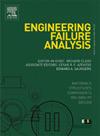不同运行策略对15mw浮式海上风电机组系泊索断裂的影响
IF 4.4
2区 工程技术
Q1 ENGINEERING, MECHANICAL
引用次数: 0
摘要
浮式海上风力发电机(FOWT)的系泊系统可能在运行条件下失效,从而增加了风电场内倾覆和碰撞的风险。为预测系泊线断裂的影响,建立了15mw半潜式FOWT的动力学模型。该方法包括基于势流理论的水动力模型、基于叶元动量(BEM)理论的气动模型和基于有限元理论的细长结构动力模型。通过时域仿真和小波分析,研究了一根系泊索断裂后基础的运动和剩余缆索的张力。结果表明,锚泊缆绳断裂会导致系统低频和高频响应的显著变化。为了减轻这些影响,还研究了紧急停机和机舱偏航失调等操作策略的性能。仿真结果表明,主动机舱偏航控制不利于系统的安全运行,尤其是横向运动和偏航运动。另一方面,关闭发电机可以显著减小漂移距离和系泊负荷。但可能会影响系统的稳定性。本文章由计算机程序翻译,如有差异,请以英文原文为准。
Effects of mooring line fracture on 15 MW floating offshore wind turbine under different operation strategies
The mooring system of a floating offshore wind turbine (FOWT) may fail under operational conditions, thereby increasing the risk of capsizing and collision within the wind farm. To predict the effects of mooring line fracture, a dynamic model is established for a 15 MW semi-submersible FOWT. This method includes a hydrodynamic model based on potential flow theory, an aerodynamic model with blade element momentum (BEM) theory, and a dynamic slender structure model using finite element theory. Through time domain simulation and wavelet analysis, the motion of the foundation and the tension in the remaining cables after one mooring line is broken are studied. The results indicate that the fractured mooring line will lead to notable changes in response at both low and high frequencies. To mitigate these impacts, the performance of operation strategies such as emergency shutdown and nacelle yaw misalignment is also examined. According to these simulations, active nacelle yaw control is detrimental to the safety of the system, especially for the transverse and yaw motions. On the other hand, shutting down the generator significantly decreases the drift distance and the mooring load. However, it may affect the stability of the system.
求助全文
通过发布文献求助,成功后即可免费获取论文全文。
去求助
来源期刊

Engineering Failure Analysis
工程技术-材料科学:表征与测试
CiteScore
7.70
自引率
20.00%
发文量
956
审稿时长
47 days
期刊介绍:
Engineering Failure Analysis publishes research papers describing the analysis of engineering failures and related studies.
Papers relating to the structure, properties and behaviour of engineering materials are encouraged, particularly those which also involve the detailed application of materials parameters to problems in engineering structures, components and design. In addition to the area of materials engineering, the interacting fields of mechanical, manufacturing, aeronautical, civil, chemical, corrosion and design engineering are considered relevant. Activity should be directed at analysing engineering failures and carrying out research to help reduce the incidences of failures and to extend the operating horizons of engineering materials.
Emphasis is placed on the mechanical properties of materials and their behaviour when influenced by structure, process and environment. Metallic, polymeric, ceramic and natural materials are all included and the application of these materials to real engineering situations should be emphasised. The use of a case-study based approach is also encouraged.
Engineering Failure Analysis provides essential reference material and critical feedback into the design process thereby contributing to the prevention of engineering failures in the future. All submissions will be subject to peer review from leading experts in the field.
 求助内容:
求助内容: 应助结果提醒方式:
应助结果提醒方式:


